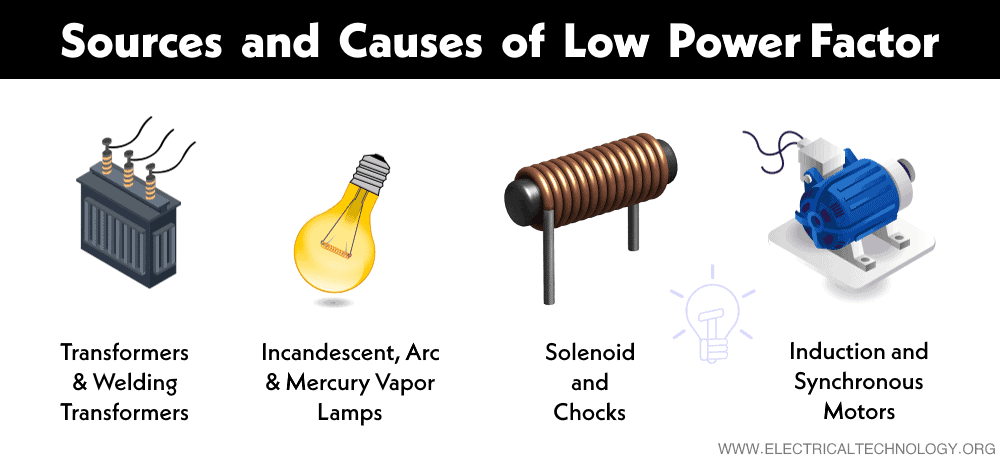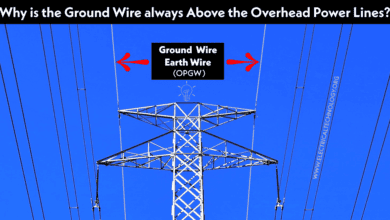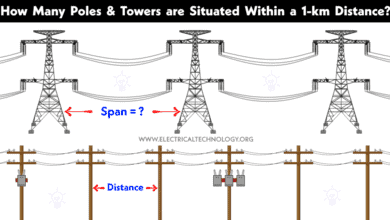Causes and Sources of Poor Power Factor
In an electrical power system, power factor is the ratio of the real power (kW) to the apparent power (kVA). A low power factor means that the electrical load is not fully utilizing the available power, which can result in increased electricity costs and reduced system efficiency. In today’s post, we will discuss the main sources and causes of low power factor in a system.
The main cause of low power factor is inductive load. In a pure inductive circuit, the current lags 90° from the voltage, causing a large phase angle difference and resulting in a zero power factor. However, in circuits with both capacitance and inductance (except for resonance or tuned circuits where inductive reactance equals capacitive reactance (XL = XC), making the circuit resistive), a power factor exists due to the difference in phase angle (θ) between current and voltage caused by capacitance and inductance.
Causes of Low Power Factor
There are several causes of low power factor, including:
- Inductive Loads: Inductive loads, such as electric motors and transformers, consume reactive power from the system, which reduces the power factor (lagging PF). This is because inductive loads cause the voltage and current to become out of phase, which increases the reactive power component of the system. For example, an inductive load operates at:
- Full load, Pf = 0.8 -0.9
- Small load, PF = 0.2 -0.3
- No Load, PF may come to almost Zero (0). i.e. the PF in pure inductor load is zero.
- Capacitive Loads: Capacitive loads, such as capacitors, generate reactive power and can improve power factor. However, if the capacitance is too high, it can cause overcompensation and lead to a leading power factor. The power factor in a pure capacitive load is zero.
- Harmonics: Harmonics are non-linear distortions of the electrical waveform that can occur in systems with electronic loads, such as computers and other electronic equipment. These distortions can cause an increase in reactive power and reduce the power factor.
- Magnetizing Current: The load on a power system varies. During periods of low load, the supply voltage is increased, which increases the magnetizing current and causes a decrease in power factor.
- Undersized Wiring: Undersized wiring (especially in motors windings) can cause voltage drops and increase the reactive power in the system, which can lower the power factor.
- Long Distribution Lines: Long distribution lines can cause voltage drops and increase the reactive power in the system, which can lower the power factor.
- Unbalanced Loads: Unbalanced loads can cause uneven distribution of power, which can increase the reactive power component and lower the power factor.
Sources of Poor Power Factor
Following are the main sources of poor power factor:
- Distribution Transformers: The PF depends on its design, loading and unloading. Generally, the PF of an unloaded transformer is very low.
- Incandescent lamps – (50% PF)
- Mercury vapor lamps – (40 – 60% PF)
- Induction motors – (30-90%)
- Synchronous motors – (Very low PF at under exited conditions)
- Welding transformers – (60%)
- Industrial heating furnaces
- Solenoid and chocks etc.
- Arc lamps
- Under exited synchronous motors working at load
- Not using rated wire size in motor windings
- Damaged bearings in motors
To improve the power factor (as low PF has many disadvantages), several solutions can be implemented, such as the installation of power factor correction equipment, upgrading electrical equipment to reduce losses, and optimizing system design to reduce reactive power consumption. Understanding the causes of low power factor is essential for identifying areas for improvement and ensuring efficient and cost-effective operation of electrical systems.
Good to Know:
- Power factor is the ratio between kW and kVA i.e. Real Power / Apparent Power. Or , the cosine of the angle between current and voltage is known as PF.
- Capacitor provides leading power factor (Where current leads the voltage).
- Inductor provides lagging power factor (where current lags behind the voltage).
- Power factor in pure resistive load is almost unity (1).
Related Posts:
- What is Power Factor?
- Disadvantages of Low Power Factor
- Advantages of Power factor improvement and Correction
- Power Factor improvement Methods with Their advantages & Disadvantages
- How to Calculate the Suitable Capacitor Size in µ-Farads & kVAR for P.F Improvement
- How to Convert Capacitor μ-Farads to kVAR and Vice Versa? – For P.F Correction
- μ-Farad to kVAR Calculator – How to Convert Farads to kVAR?
- kVAR to Farad Calculator – How to Convert kVAR to μ-Farads?
- Capacitor Bank in kVAR & µF Calculator for Power Factor Correction
- Capacitor Bank – Characteristics And Applications
- Power Factor Correction Calculator – How to Find P.F Capacitor in µF & kVAR?
- Active, Reactive, Apparent and Complex Power
- Difference Between Active and Reactive Power – Watts vs VA
- Introduction of Custom Power Devices For Power Quality Improvement
- Analysis of Reactive Power in Power System
- Is Reactive Power Useful? Importance of Reactive Power
- What is Static VAR Compensator (SVC)? Construction, Working and Applicators

 What is the Power Angle in a Power Transmission Line?
What is the Power Angle in a Power Transmission Line? What is Sag in Overhead Power Transmission Lines?
What is Sag in Overhead Power Transmission Lines? Why is the Ground Wire Always Positioned Above the Overhead Power Lines?
Why is the Ground Wire Always Positioned Above the Overhead Power Lines? What is the Minimum Ground Clearance for Overhead Power Line?
What is the Minimum Ground Clearance for Overhead Power Line? How Many Poles and Towers are Situated Within a 1-km Span?
How Many Poles and Towers are Situated Within a 1-km Span? Why are Overhead Power Transmission Lines Not Insulated?
Why are Overhead Power Transmission Lines Not Insulated?